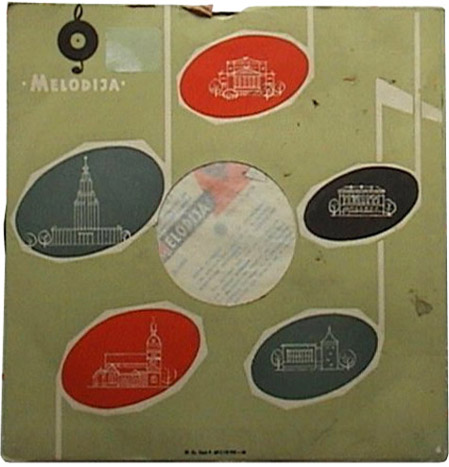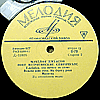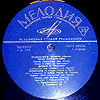
It was established in 1964 as the "All-Union Gramophone Record Firm of the USSR Ministry of Culture Melodiya". It utilized gigantic resources of numerous recording studios, manufacturing facilities throughout the USSR as well as powerful centres of distribution and promotion system. The best selling format at the time was 33⅓ and 78 RPM vinyl records. As of 1973 Melodiya released some 1,200 gramophone records with the total circulation of 190-200 million per year and 1 million compact cassettes per year and was exporting its production into more than 70 countries.
The firm's production was dominated by classical music and music by Soviet composers and musicians, performances by Soviet theater actors, fairy tales for children, etc. For example, Melodiya released performances of works by Peter Tchaikovsky and Shostakovich, which were valued for their authenticity. Melodiya also released some of the most successful western pop, jazz and rock records which included Michael Jackson, ABBA, Paul McCartney, Boney M., Dave Grusin, Amanda Lear, and Bon Jovi.
In other countries, Melodiya recordings imported from the USSR were often sold under the label MK, which stood for Mezhdunarodnaya Kniga ("International Book", Russian: Μеждународная Книга). In the United States, many Melodiya recordings appeared on the domestically manufactured Monitor Records label. In the 1970s and 1980s, Melodiya recordings of classical and folk music appeared on the Melodiya/Angel (USA) and Melodiya/HMV (elsewhere) labels as the result of an exclusive contract with EMI, the owner of both labels. A smaller number of recordings were distributed on other labels, particularly after 1989, before Melodiya granted exclusive rights to BMG in 1994. In at least one instance, one Melodiya record album, Gennady Rozhdestvensky's recording of Tchaikovsky's ballet The Nutcracker, made in 1960, appeared on LP in the U.S. on the Columbia Masterworks label. After expiry of the BMG contract in 2003, the company re-opened under new management and in 2006 started re-releasing recordings under its own label.
Being state owned until c.1989, the Soviet recording industry was able to apply a single numbering system to all its releases from 1933 onwards irrespective of origin or place of manufacture. The number sequences for 78s and LPs are strictly chronological, from which it is possible to date many, though not all, releases from the catalogue number.
Since 2008, some of Melodiya records are available to North American listeners through the Canadian classical label Analekta which is distributed by Koch Entertainment in the USA and Distribution Select in Canada.
From the middle sixties to late eighties 99% of Russian vinyl records were issued on Melodiya label. I have seen occasional records on Akkord label, probably more of them existed but too few to be considered.
First it should be mentioned that from early 60-ies to mid 70-ies not all records had their "personal" picture sleeves. 7", 10" and even 12" records were housed in standard Melodiya factory sleeves. Personal sleeves are found only on few sixties LP's. And even by the mid-eighties there were LP's in such factory sleeves. Soviet economy was a strange thing... So don't be confused when offered a Russian 1980 pressing LP in factory sleeve - it's OK. Some records (both 7" and LP's) had never got their own, picture sleeves.
Determining the year and pressing
Below please find a table of Melodiya catalog numbers for LP's. After each year you'll see the first MONO LP issued this year and first STEREO LP issued this year.
|
This table lets you determine exactly when was a particular album issued (NOT PRESSED!) - please keep in mind that usually LP's reissues had original numbers (see above). A few more clues may help you to find out if your record is a first pressing or a re-issue:
These clues are:
- manufacturing standard (
 ) with 6 digits placed on the label near the spindle hole. Throughout 1961 to early 1969 Melodiya records had ГОСТ 5289-61
) with 6 digits placed on the label near the spindle hole. Throughout 1961 to early 1969 Melodiya records had ГОСТ 5289-61
Throughout 1969 to early 1974 Melodiya records had ГОСТ 5289-68
Throughout 1974 to early 1980 Melodiya records had ГОСТ 5289-73
Throughout 1980 to early 1989 Melodiya records had ГОСТ 5289-80
From 1989 and on Melodiya records had ГОСТ 5289-88 - label color
- label design.
Here's the overview of Melodiya labels:
Pressing plants
In the USSR there were several record plants. Records' labels are slightly different for these plants although all the rules mentioned above are true. It's curious that often record plants used different sleeve artwork versions for the same album.- Aprelevsky plant (Moscow)
- Leningradsky plant (Leningrad)
- Riga plant (Riga, Latvia)
- Opytny plant "Gramzapis'" (test plant - Moscow)
- Tashkent plant (Tashkent, Uzbekistan)
- Tbilisi plant (Tbilisi, Georgia)
- Leningrad, Moscow and Riga pressings are most common and Tbilisi pressings are the rarest.
Below are some examples of Riga pressing plant company sleeves:
Company sleeve variations 1949 - 1964 (pre-Melodiya)


Pre-1964 company sleeve (when the factory was known as Riga Records Factory)

Company sleeve ca 1964 front
Company sleeve ca 1964 back - and label


Circa 1968 - die cut sleeve Label ca 1968
Company sleeve 1967, celebrating company's 50 year anniversary - front and back
Company picture sleeve from ethnographic series 1968 front and back
Company picture sleeve from ethnographic series ca 1969-70 front and back
Company picture sleeve from ethnographic series ca 1971-72 front and back
Company picture sleeve ca 1974 front and back, note that the shades of yellow may vary from very light to dark
Another "standard issue" sleeve from 1974 with ethnic motif


Company sleeve 1975 Another early 70s company p/s










No comments:
Post a Comment